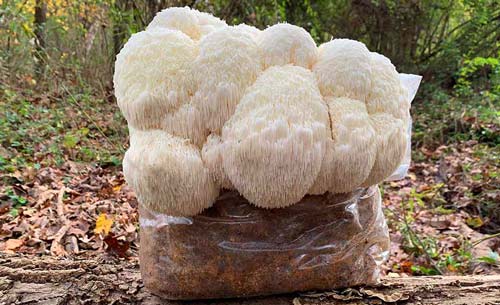Lion’s Mane Mushrooms
Lion’s Mane mushrooms (Hericium erinaceus) are delicious and nutritious, with a lot of potential health benefits. They’re also one of the most distinctive looking mushrooms you’ll come across; large, white, shaggy mushrooms that resemble a lion’s mane as they grow, hence the name. They can be eaten or taken in the form of supplements and have been used in Chinese food and medicine for centuries. They contain bioactive substances that have many beneficial effects on the body, especially the brain, heart, and gut.

Lion’s mane mushroom
Lion’s Mane is full of a multitude of important compounds, such as beta-glucans, which are immuno-modulating antioxidants and neuro-protective phytonutrients. Traditional Chinese Medicine practitioners use this mushroom for the spleen, along with its association with digestion, energy, and water regulation. Chinese Medicine also uses them as a tonic for stress-related disorders (neurasthenia) and for a lack of energy (qi deficiency).
Studies have found that lion’s mane mushrooms contain two special compounds that can stimulate the growth of brain cells: hericenones and erinacines and that lion’s mane may help protect against Alzheimer’s disease, a degenerative brain disease that causes progressive memory loss. The ability of lion’s mane mushroom to promote nerve growth and protect the brain from Alzheimer’s-related damage may explain some of its beneficial effects on brain health.
One small 2010 study of menopausal women in Japan found that eating cookies containing lion’s mane mushrooms daily for 1 month helped reduce self-reported feelings of irritation and anxiety.
Eating Lion’s Mane Mushrooms
These distinctive-looking mushrooms have a soft, spongy texture with an internal structure quite similar to cauliflower, with branches extending from a single base. They have a mild and slightly sweet flavour, said by many to be similar to crab or lobster. When cooked, the ‘teeth’ have a texture similar to meat, making them a great meat substitute in vegetarian dishes.
Lion’s mane mushrooms can be versatile, serving as a main ingredient or a side dish. They are typically sliced into rounds or cut lengthways into long slices and pan-fried. They can also be used to make “crab” cakes or in soups and sauces. Because of their spongy texture they are very good at soaking up flavours.
Growing Lion’s Mane mushrooms
Lion’s mane mushrooms are relatively easy to grow, but are not the ideal first choice for beginners as their mycelium is very fine, making if tricky to decide when substrates are fully colonised and ready for fruiting. They can be grown at home in grow bags or using logs, but it’s worth noting that growing lion’s mane on logs isn’t a quick process – it takes one to two years after inoculation to harvest your first batch of fresh mushrooms.
Growing lion’s mane indoors in bags or containers is significantly easier and quicker. From innoculation of your substrate it could be as little as a month before you harvest your first crop. As a rough timetable, the colonisation stage takes around 12 – 19 days, during which the mycelium spreads throughout the substrate. Once fully colonized and placed in a fruiting chamber, the first pins (the first stages of mushroom growth) will then appear in around 3-7 days. From that point, the mushrooms will keep growing and be ready to harvest in another 5-10 days, dependent on temperature.
From experience, hardwood pellets mixed with bran are probably the best substrates for this type of mushroom. On their own, hardwood pellets don’t need to be sterilized because the pellet production process does this. However, because you’re adding the pellets to wheat or oat bran, it means the combined substrate does need to be sterilised.
Note of caution
It’s worth noting, as is the case with most mushrooms, that the medicinal benefits they are credited with offering shouldn’t be taken as gospel or medically proven. While positive effects have been demonstrated in tests on animals, and in small scale human tests, more research on human benefits is generally acknowledged to be needed for any results to be conclusive. That’s not to say the claims are bogus, only that they haven’t been tested as strictly as mainstream pharmaceutical products.
